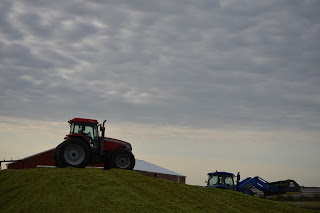
We put up our corn silage the first week of September. What is silage you may be wondering? Silage is grass or green fodder, in our case corn, which is compacted and stored without being dried first and is used as feed during the wintertime. Others use silage as feed year-round. Some may store their silage in silos, bunkers or bags. We pack our silage pile right on top of the ground in our hay yard, near our feed lot where we feed cows, heifers and yearling bulls during the winter.
 |
Doug, left, drives on top of the silage pile to pack the silage tight while Paul prepares to turn around and the silage truck empties its load Sept. 5.
|
Corn silage is a high-energy feed stuff which we can produce at a relatively low cost compared to other feed stuffs. When making corn silage, a chopper harvests the entire corn plant; nothing goes to waste. The corn plant is chopped into small pieces gathered in a silage truck. The trucks dump the freshly cut corn near the pile while loader tractors work to form and pack the pile.
 |
| Patrick, left, and Paul push silage to form the pile Sept. 5. All hands are on deck during silage production. |
As the chopped corn is compressed, the pile beings to ensile. The cells of the corn plant are alive and breathing; the breathing forms carbon dioxide and heat by using the trapped air. As the carbon dioxide increases, an anaerobic condition is formed in the pile. Good bacteria start the fermentation process when the plant respiration stops. The fermentation allows the pH to drop to a level where no organism, mold or undesirable bacteria, can function.
 |
| Doug drives on top of the silage pile Sept. 5. |
Essentially, we cut our corn plant into tiny pieces, pack it like you are trying to fill a 20-percent-off bucket, let it do its magic and voila... corn cocktail, made fresh for bovines in North Dakota.
 We put up our corn silage the first week of September. What is silage you may be wondering? Silage is grass or green fodder, in our case corn, which is compacted and stored without being dried first and is used as feed during the wintertime. Others use silage as feed year-round. Some may store their silage in silos, bunkers or bags. We pack our silage pile right on top of the ground in our hay yard, near our feed lot where we feed cows, heifers and yearling bulls during the winter.
We put up our corn silage the first week of September. What is silage you may be wondering? Silage is grass or green fodder, in our case corn, which is compacted and stored without being dried first and is used as feed during the wintertime. Others use silage as feed year-round. Some may store their silage in silos, bunkers or bags. We pack our silage pile right on top of the ground in our hay yard, near our feed lot where we feed cows, heifers and yearling bulls during the winter.



Comments
Post a Comment